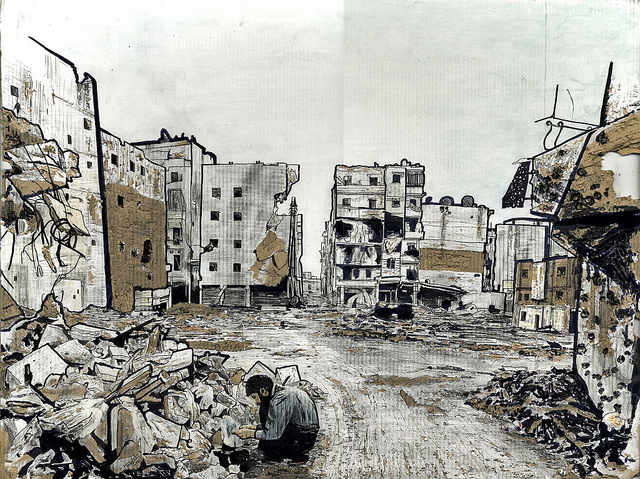As the world bemoans the Syrian refugee crisis, Syrians themselves like to joke that Bashar al-Assad is just trying to get the population back to where it was when he started.
The population was about 18 million when he took office in 2000, but it swelled to roughly 22 million in 2011, when demonstrators began calling for him to step down. Yet five years of starvation sieges and barrel bombs, and the rise of Isis, have emptied the country of almost six million inhabitants. The joke is old and Assad has clearly overshot the mark—he has a way of overshooting things, after all. Many would go further, saying he is actually trying to take Syria back to the stone ages.
The conflict began when the Assad regime assassinated a thousand pro-democracy demonstrators over the course of three months in the spring of 2011. This prompted defectors from the national army who did not want to fire on protesters to form militias in defense of demonstrators and their communities. Since that time roughly half a million people have been killed, the vast bulk of them by the regime. Most of the killing has been done through barrel-bombs—rusty old barrels, filled with shrapnel and chlorine—indiscriminately dropped on civilians by the regime, which has the only air force. The bombings have obliterated massive portions of three of Syria’s four largest cities.
The Assad regime terrorizes the local population until they depart, then mops up the poorly armed rebels. According to the U.N., the regime is currently besieging and starving over half a million people in cities it seeks to control. And it has tortured to death well over 17,000 detainees, 11,000 of whose dead and mutilated bodies were photographed by the regime and then leaked, as documented by Amnesty International. But since the regime has disappeared over 65,000 people since the beginning of the war, who are seldom heard from family again, and since there are numerous prisons to which Amnesty lacks access, this number could be vastly higher. Supporters of the rebels say they will never surrender because they believe that if they do they will be slaughtered in prison and their communities ethnically cleansed.
Anyone concerned with the suffering of Syrians would do well to begin with this recognition of who started the killing, who is doing the vast bulk of it, and why so many Syrians have become refugees. But the Assad regime is not operating in a vacuum. There are four principal local forces fighting in Syria. The Assad regime, an authoritarian dictatorship in power since the early 70s; the rebels, an array of militias fighting for a democratic state; the Kurds, a disenfranchised minority fighting for their survival; and Isis, which contrary to popular opinion, has not been fighting the regime but rather the Kurds and rebels militias, which have long united in opposition to Isis.
The war began when defectors from Assad’s army formed militias to protect protesters, who were being assassinated by the regime. These militias were formed locally and loosely coordinated as the Free Syria Army. The Free Syria Army was initially secular, but the Assad regime claimed the Arab Spring protesters who took to the streets demanding democratic change were terrorists. A virtual consensus of neutral observers has treated the claim as absurd, but the composition of rebel groups has changed over time, and the traumas of war and the search for weapons and funding have led many to join jihadist groups.
There are many imperialisms at work in Syria: Russian, Iranian, Turkish, Saudi, American, Qatari and British. And each state is funding and supporting its own favored groups. But the secular militias of the Free Syria Army, which America is supporting, are by most counts the worst supplied. An Italian journalist, Francesca Borri, notes that the soldiers she found in Aleppo were so poor they did not wear uniforms but could rather be identified by their flip-flops. And it is for just this reason that many drifted to the better funded jihadist groups.
The most prominent and problematic of these is the Nusra Front, which was started in Syria, but affiliated with Al-Qaeda early in its development to garner support. The affiliation was a mixed blessing, which brought in massive funding from Saudi donors but also the ire of America. Unfortunately, Nusra was by many accounts the most effective fighting force in the revolution, though its numbers have been quite small. And for much of the conflict they mostly kept quiet and protected Syrian civilians from regime attacks. Nusra has often protected civilians, but it has also at times imposed strict religious rule, and their presence has complicated American and British support for the rebels.
The Assad regime deliberately sought to foster a narrative from the very beginning that suggested Assad was the only thing standing between the jihadists and their control of the state. However, most Syrians say there were no jihadists in Syria in 2011, and experts on Isis agree that the regime is not fighting them in any serious way and did many things to foster their rise. Most importantly, Assad released key jihadists from prison in 2012; he did not fight Isis on numerous occasions when he had the chance; and somewhat astoundingly, he used Isis as his regime’s principle supplier of oil, which constituted one of its primary sources of funding.
The most knowledgeable Syria watchers tell me the Obama administration is tightly controlling rebel access to anti-aircraft weaponry. This may be because the American-Israel Public Affairs Committee has lobbied hard for this restriction, probably to keep them from falling into the hands of Hezbollah. But a more sinister interpretation says the U.S. wants to prolong the fighting. However, if we take the Obama administration at its word, if we follow its strategy of negotiations, or if we take the American desire to keep oil flowing in a stable Middle East seriously, a more considered opinion suggests the Obama administration wants Assad to step down under a controlled and responsible transition. While administration officials may occasionally condemn the war crimes of Assad and Putin, while they may support a handful of safe militias, while high ranking officials may occasionally declare they want Assad to step down, most people closely studying the issue believe they are actually doing quite little to bring down the regime.
But the Assad regime is not nearly so stable and strong as people tend to think. The regime’s officer corps is largely staffed by the Iranian National Guard, whom many say are now directing its operations. And it has granted control of much of the country to the Islamist group Hezbollah. For years now, the regime has paid self-directing militias, dubbed Shabiha or ghosts, to carry out the worst atrocities. And the regime has allied itself with an array of militias, many of which have begun to come into conflict with it. Hence, establishing “state control” after the conflict is over, will be extremely difficult without some sort national consensus, which would be unusually difficult under a regime which has destroyed many of its own major cities.
There are, of course, many ways of framing what is happening in Syria. And there are a number of major leftist journalists, like Charles Glass and Robert Fisk, who tell a different story and have come out strongly in favor of the regime. This counter-narrative tends to be heavy on conspiracies and views the U.S. as the principal player in Syria. But Syrians, like the Princeton trained academic, Karam Nachar, have told me they find this view to be racist in its failure to see any agency among the Syrians themselves—as if Syrians could not start their own revolution.
Nachar also notes that it ignores the shift from a uni-polar to multi-polar war in which there are many imperial powers. Personally, I find most of these accounts to be shallow in that they lack a systemic understanding of the conflict; reactive in that they are more focused on what they don’t want to happen than on what is really happening; nationalistic in that they treat Syria as if it is all about American foreign policy as opposed to Syrians themselves; and morally stunted in their willingness to to overlook massive crimes against humanity.
My own narrative cleaves close to a virtual consensus among academic specialists, humanitarian organizations and Syrians and Iraqis themselves, whom I have interviewed in several trips to the region and online over the course of the past few years. But what Syrians say the most is they just want the conflict to end. If this virtual consensus of experts is right, this may not be as easy as it sounds. And those who suggest it is may be causing more harm than they could possibly imagine.
Theo Horesh is the author of Convergence: The Globalization of Mind. If you liked this article friend him on Facebook and join the dialogue.
~
Author: Theo Horesh
Image: Flickr/Joshua Tabti
Editor: Travis May
 Share on bsky
Share on bsky






Read 1 comment and reply